Havana Inside & Out PLUS
Be a local for a day!
Capital of all Cubans, Havana is simply a lively and colorful city plenty of bustle and entertainment, with some splendid architectural gems from the Colonial period and beyond. Founded on 1519 as San Cristobal of Havana, it is still today the main economic, political, cultural and social hub of the country. Everything, from the beauty of buildings architecture to the treasure of museums, invites you to get deeper within the street maze. Its old section along with the defense system were declared by UNESCO a World Heritage Site in 1982, the historic heart of Havana is the largest Colonial center in Latin America where time seems to stand still there!
Havana under the Sun & Stars
Experience Havana's history, art, political legacy, remarkable highlights and delicious cuisine. Get ready to experience an evening full of Cuban culture, flavors and entertainment. Be blown away by the concert of the Grammy Award-winning group Buena Vista Social Club; the stage is set for you to be delighted by Cuba’s world-famous Tropicana Cabaret; the Cuban Art Factory proposes diverse art expressions; the cannon shot ceremony El Cañonazo awaits at 9:00 pm; Jazz Clubs always featuring magic nights and notorious bars inviting you to sip their cocktails. It is your call!
Havana & Hemingway
Discover why the American novelist fell in love for Havana's vibrant soul, where he lived, fished, wrote, dined and sipped his favorite cocktails. Visit his haunts, his former farm Finca Vigía, Cojimar fishing village, Hotel Ambos Mundos’ room 511, El Floridita, La Bodeguita del Medio and Sloppy Joe's bars. Today, his footprints resist to fade away as he refused to leave Cuba in 1960 upon the U.S. ambassador's suggestion to give up his beloved tropical home because Washington was cutting off relations with Cuba. Find out why although dead 57 years ago, he is almost as palpable a presence as he was back in those days.
Viñales
Viñales is the perfect combination of natural beauty and traditional Cuban culture. It is best known for its tobacco farms and the distinctive limestone hills of Valle de Viñales, a stunning UNESCO World Heritage Site blessed by fertile rust-red soil and cigar-chewing guajiros (peasants) driving their oxen and plow through a tobacco field. It offers Cuba's very best hiking, caving and vistas, based around the tranquil farming town of Viñales on the edge of the park.
PROGRAM
- Pick up at a meeting point outside Cruise Ship Terminal in Havana at 9:30 am or 2:30 pm depending on your Cruise Ship arrival.
- Walking tour in Old Havana: Visit to Saint Francis of Assisi Square, Arms Square, Old Square and Cathedral Square, El Floridita bar, La Bodeguita del Medio bar, Hotel Ambos Mundos (Ernest Hemingway's regular bars and hotel in Old Havana).
- Visit to the surroundings of the Morro-Cabaña fortresses complex.
- Panoramic tour through the seafront avenue, “Malecón”, the Revolution Square, Central Park, Opera House, Capitol building, former Bacardi Building, Prado promenade, Sloppy Joe's Bar and Museum of the Revolution, former Presidential Palace. Stop at these places for pictures.
- Lunch at a local private restaurant: “Paladar” (price varies depending on your choice).
- Visit to Fusterlandia, home neighborhood of a Cuban artist in the suburbs of Havana who turned his own house and surroundings into a masterpiece of intricate tilework inspired in Gaudi and Picasso.
- Ride for 30 minutes in a vintage convertible car. Travel back in time to the 50's and Live it up and do it your way like Frankie!!!!
- Optional visit to a flea market.
- Optional visit to Havana Club Rum Museum and Columbus Cemetery.
- Drop off at the Cruise Ship Terminal.
Book this Excursion
Important Notes:
- Duration: hours.
- Meeting point: San Felipe de Bejucal Hotel, in front of the Cruise Ship Terminal across Saint Francis of Assisi square.
- Quality: Experienced, Reliable, English speaking local guides.
- Convenient: Port pick-up with private air-conditioned and insured transportation
- Personalized: Fully customizable tour itineraries.
- Service: 24/7 Customer Support.
- Reliable: Return to ship guarantee.
- Payment in USD cash is required at the end of the tour. Keep in mind that we don’t accept local currency. Moreover all the places you will go such as restaurants/shops/flea market will only accept international currencies (EUR, GBP, CAD) but preferably USD.
- In case of American citizens, this cultural exchange includes a full-time schedule of activities intended to enhance contact and support for Cubans. All our tours fall under the Support for the Cuban People Category.
CONTACT US
- PHONES: 53-52479150
- cubanconnectiontour@gmail.com
- www.facebook.com/CubanConnectionTour1





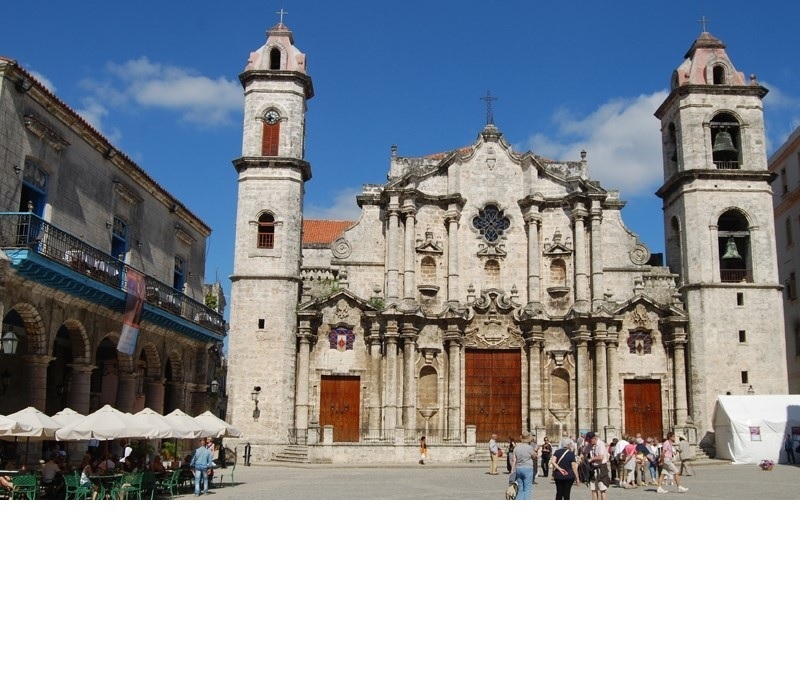 It was
originally known as Swamp Square because of the marshy land and
subterranean springs. A church built by the Jesuit order (1748-1776) was
promoted to the status of cathedral 1789, thus the original plaza
became Cathedral Square. Some aristocratic buildings appeared later as
Lombillo, Marquis of Aguas Claras and Marquis of Arcos palaces. The
cathedral´s Baroque façade is grandiose with two large asymmetrical
towers and its neoclassical interior treasures frescoes by Italian
Giovani Perovani and Jean Baptiste Vermay. Pope John Paul II visited it
in 1998.
It was
originally known as Swamp Square because of the marshy land and
subterranean springs. A church built by the Jesuit order (1748-1776) was
promoted to the status of cathedral 1789, thus the original plaza
became Cathedral Square. Some aristocratic buildings appeared later as
Lombillo, Marquis of Aguas Claras and Marquis of Arcos palaces. The
cathedral´s Baroque façade is grandiose with two large asymmetrical
towers and its neoclassical interior treasures frescoes by Italian
Giovani Perovani and Jean Baptiste Vermay. Pope John Paul II visited it
in 1998. This construction was conceived in 1953 as Civic Square, on the 100th anniversary of the Cuban national hero´s birth and finished in 1959 when it was renamed as Revolution Square. It consists of a 142 meters tower representing a five pointed star and a huge statue of José Martí whose Memorial is in the interior of the base. Since 1959 it has been Cuba´s political and administrative center and the main venue for political rallies and official celebrations. Pope John Paul II in 1998 and Pope Benedicto XVI in 2012 celebrated masses together with thousands of worshipers.
This construction was conceived in 1953 as Civic Square, on the 100th anniversary of the Cuban national hero´s birth and finished in 1959 when it was renamed as Revolution Square. It consists of a 142 meters tower representing a five pointed star and a huge statue of José Martí whose Memorial is in the interior of the base. Since 1959 it has been Cuba´s political and administrative center and the main venue for political rallies and official celebrations. Pope John Paul II in 1998 and Pope Benedicto XVI in 2012 celebrated masses together with thousands of worshipers. Construction
of this fortress was designed by Bautista Antonelli and built between
1589 and 1630. The original lighthouse was rebuilt many times, the one
that still stands today is from 1845 and has its original lamp. Havana
was a highly prized target for enemies and pirates for its extremely
favorable strategic position in the Caribbean and became the most
fortified city in any Spanish colony. It was declared a UNESCO site as
part of the city´s defense system along with other fortresses as
La Cabaña, La Real Fuerza, La Punta, etc.
Construction
of this fortress was designed by Bautista Antonelli and built between
1589 and 1630. The original lighthouse was rebuilt many times, the one
that still stands today is from 1845 and has its original lamp. Havana
was a highly prized target for enemies and pirates for its extremely
favorable strategic position in the Caribbean and became the most
fortified city in any Spanish colony. It was declared a UNESCO site as
part of the city´s defense system along with other fortresses as
La Cabaña, La Real Fuerza, La Punta, etc.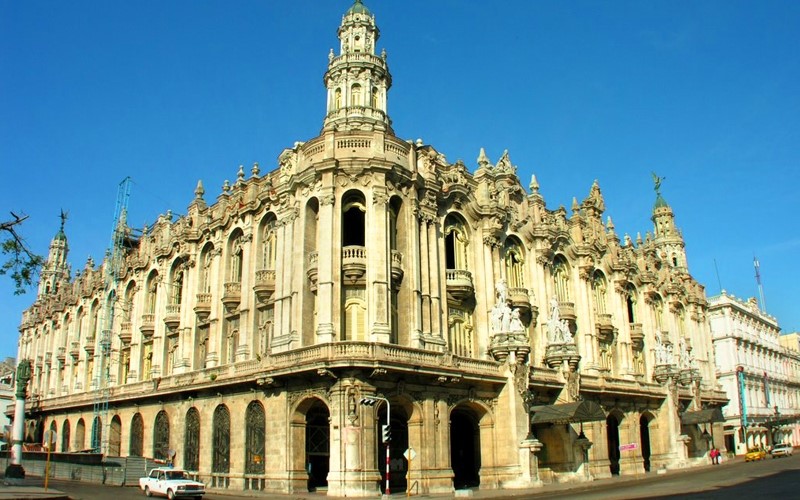 It was designed by Belgian architect Paul Belau to host the social activities of Havana´s large and affluent Spanish community. The magnificent façade is decorated with four sculpture groups depicting Charity, Education, Music and Theater. It was built over the foundations of the Tacón Theater which opened on November 1837. The present building was inaugurated on 1915 and has witnessed world famous artist as Fanny Essler, Verdi, Sarah Bernhardt, Arthur Rubinstein, Anna Pavlova and Alicia Alonso, etc. Today, it houses the National Ballet of Cuba.
It was designed by Belgian architect Paul Belau to host the social activities of Havana´s large and affluent Spanish community. The magnificent façade is decorated with four sculpture groups depicting Charity, Education, Music and Theater. It was built over the foundations of the Tacón Theater which opened on November 1837. The present building was inaugurated on 1915 and has witnessed world famous artist as Fanny Essler, Verdi, Sarah Bernhardt, Arthur Rubinstein, Anna Pavlova and Alicia Alonso, etc. Today, it houses the National Ballet of Cuba. The Cuban
Capitol, Inaugurated on May 20th, 1929 was the seat of the House of
Representatives and the Senate until 1959. It marks the 0 kilometer of
Cuba’s highways system. Its almost 92 meters high dome, the Chamber of
Deputies, the Hall of Lost Steps and the statue “the Republic”, made by
the Italian artist Angelo Zanelli, the third largest indoor statue in
the world are among its many attractions. Today, it houses the Ministry
of Science, Technology and Environment.
The Cuban
Capitol, Inaugurated on May 20th, 1929 was the seat of the House of
Representatives and the Senate until 1959. It marks the 0 kilometer of
Cuba’s highways system. Its almost 92 meters high dome, the Chamber of
Deputies, the Hall of Lost Steps and the statue “the Republic”, made by
the Italian artist Angelo Zanelli, the third largest indoor statue in
the world are among its many attractions. Today, it houses the Ministry
of Science, Technology and Environment. The hustle
and bustle at San Francisco Square bothered religious services at the
Basilica. The Franciscan fathers requested the creation of a square for
exclusive commercial use, named New Square. After the creation of other
urban areas in the 19th century it lost its initial name becoming Old
Square. Cristina Market was built in the center in honor of the Queen,
being demolished in 1908. Administrative and business offices sprang up
with the 20th Century and a small amphitheater with a parking lot
beneath were built in 1952 which are no longer part of this square after
its restoration.
The hustle
and bustle at San Francisco Square bothered religious services at the
Basilica. The Franciscan fathers requested the creation of a square for
exclusive commercial use, named New Square. After the creation of other
urban areas in the 19th century it lost its initial name becoming Old
Square. Cristina Market was built in the center in honor of the Queen,
being demolished in 1908. Administrative and business offices sprang up
with the 20th Century and a small amphitheater with a parking lot
beneath were built in 1952 which are no longer part of this square after
its restoration. Its location
made it the center of imports, export, sailors and troops disembarking.
The construction of a humble Franciscan convent, later one of the most
beautiful buildings in the area, gave its name to the open space. The
Fountain of the Lions, donated by Villanueva Count in 1836 and sculpted
in Carrara marble, supplied for many years the ships docked here with
drinking water. The Stock Exchange (1909) and the Customs House (1914)
were added to the physiognomy of the square.
Its location
made it the center of imports, export, sailors and troops disembarking.
The construction of a humble Franciscan convent, later one of the most
beautiful buildings in the area, gave its name to the open space. The
Fountain of the Lions, donated by Villanueva Count in 1836 and sculpted
in Carrara marble, supplied for many years the ships docked here with
drinking water. The Stock Exchange (1909) and the Customs House (1914)
were added to the physiognomy of the square. Neoclassic
monument inaugurated in 1828 as a remembrance to the foundation of Saint
Christopher of Havana. It stands where there was a silk-cotton tree,
under whose shadow the first Mass and city council were held on November
16th, 1519. Inside, there are three canvases by Jean Baptiste Vermay
depicting these scenes. Every year on November 16th, locals would circle
the tree three times, knock on its trunk three times and ask for their
wishes as part of a town tradition.
Neoclassic
monument inaugurated in 1828 as a remembrance to the foundation of Saint
Christopher of Havana. It stands where there was a silk-cotton tree,
under whose shadow the first Mass and city council were held on November
16th, 1519. Inside, there are three canvases by Jean Baptiste Vermay
depicting these scenes. Every year on November 16th, locals would circle
the tree three times, knock on its trunk three times and ask for their
wishes as part of a town tradition. This
seafront promenade runs for 7 km alongside the city´s historic quarters,
from the colonial center to the skyscrapers of El Vedado. This busy
boulevard is lined with many attractive buildings whose pastel hues have
faded in the sun and salty air. It is magical at sunset, popular among
fishermen, and the perfect place for people to hang out, meet friends
and socialize.
This
seafront promenade runs for 7 km alongside the city´s historic quarters,
from the colonial center to the skyscrapers of El Vedado. This busy
boulevard is lined with many attractive buildings whose pastel hues have
faded in the sun and salty air. It is magical at sunset, popular among
fishermen, and the perfect place for people to hang out, meet friends
and socialize.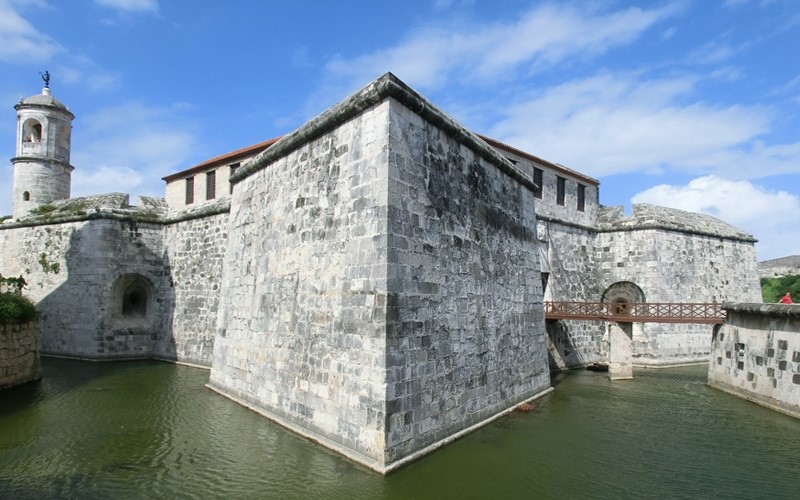 This
fortress was built in 1558-1577 to protect the city from pirate attacks
and is the oldest military construction in Havana. Despite its perfect
Renaissance architecture, it couldn´t be efficient as it was built too
far inside the bay, in a low area. It was used as warehouse, Governor´s
residence, barracks, National Archive, Army Headquarters, National
Library, and Arms Museum, etc. The Giraldilla, a sculpture cast in
bronze by Havana artist Jerónimo Martínez Pinzón was placed as a weather
vane on top of the Northwest tower in the 1630s and became a city´s
symbol.
This
fortress was built in 1558-1577 to protect the city from pirate attacks
and is the oldest military construction in Havana. Despite its perfect
Renaissance architecture, it couldn´t be efficient as it was built too
far inside the bay, in a low area. It was used as warehouse, Governor´s
residence, barracks, National Archive, Army Headquarters, National
Library, and Arms Museum, etc. The Giraldilla, a sculpture cast in
bronze by Havana artist Jerónimo Martínez Pinzón was placed as a weather
vane on top of the Northwest tower in the 1630s and became a city´s
symbol. The Central
Plaza was built in 1877 after the old city walls were demolished. Since
February 1905, its large esplanade is presided by a statue of José
Martí, which replaced a marble statue of Isabel II of Spain. The Central
Plaza is surrounded by significant buildings, such as the Grand Theater
of Havana, the Inglaterra, Telégrafo, Plaza and Parque Central Hotels,
the old Gómez Mena mall, the Universal Art building of the Fine Arts
National Museum and the Payret Movie Theater.
The Central
Plaza was built in 1877 after the old city walls were demolished. Since
February 1905, its large esplanade is presided by a statue of José
Martí, which replaced a marble statue of Isabel II of Spain. The Central
Plaza is surrounded by significant buildings, such as the Grand Theater
of Havana, the Inglaterra, Telégrafo, Plaza and Parque Central Hotels,
the old Gómez Mena mall, the Universal Art building of the Fine Arts
National Museum and the Payret Movie Theater. The
residence of 22 Cuban presidents since 1920 until 1959 was designed by
Carlos Maruri and Paul Belau and decorated by Teffany of New York. The
museum features documents, photographs of the different historical
processes in Cuba. The Granma Memorial treasures the boat which brought
Fidel Castro and his comrades from Mexico to begin the armed struggle
against Batista. There also objects and vehicles relating to the
invasion of the Bay of Pigs and missile crisis, etc.
The
residence of 22 Cuban presidents since 1920 until 1959 was designed by
Carlos Maruri and Paul Belau and decorated by Teffany of New York. The
museum features documents, photographs of the different historical
processes in Cuba. The Granma Memorial treasures the boat which brought
Fidel Castro and his comrades from Mexico to begin the armed struggle
against Batista. There also objects and vehicles relating to the
invasion of the Bay of Pigs and missile crisis, etc.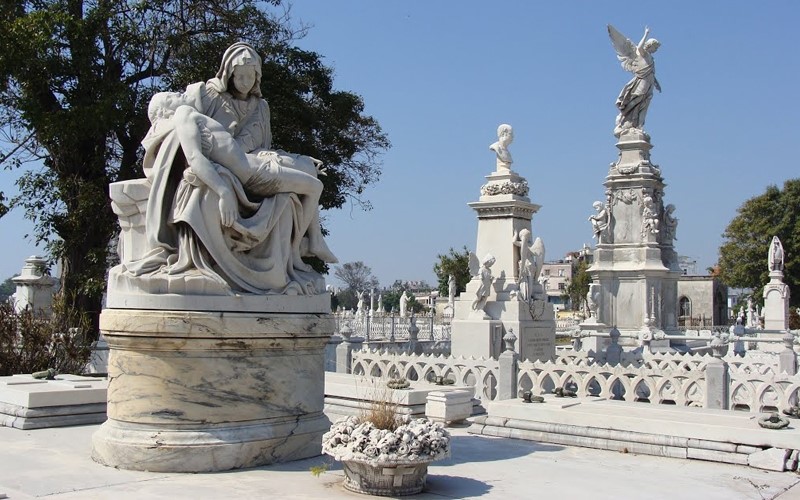 Havana’s
monumental Cemetery, built in (1871-1886), is one of the largest in the
world, occupying an area of 57 hectares. Because of its many sculptures
and monuments from eclectic to contemporary art, the Necropolis was
proclaimed a National Monument in 1987. It was designed by Calixto de
Loira as a Roman military camp. The statue in Carrara marble of the
three theological virtues Faith, Hope and Charity which crowns the front
gate was sculpted in 1904 by the Cuban artist José Villalta de
Saavedra. The most visited grave, “The Miraculous one”, is the tomb of
Amelia Goyri de la Hoz who became a protector of pregnant women and
newborn children.
Havana’s
monumental Cemetery, built in (1871-1886), is one of the largest in the
world, occupying an area of 57 hectares. Because of its many sculptures
and monuments from eclectic to contemporary art, the Necropolis was
proclaimed a National Monument in 1987. It was designed by Calixto de
Loira as a Roman military camp. The statue in Carrara marble of the
three theological virtues Faith, Hope and Charity which crowns the front
gate was sculpted in 1904 by the Cuban artist José Villalta de
Saavedra. The most visited grave, “The Miraculous one”, is the tomb of
Amelia Goyri de la Hoz who became a protector of pregnant women and
newborn children.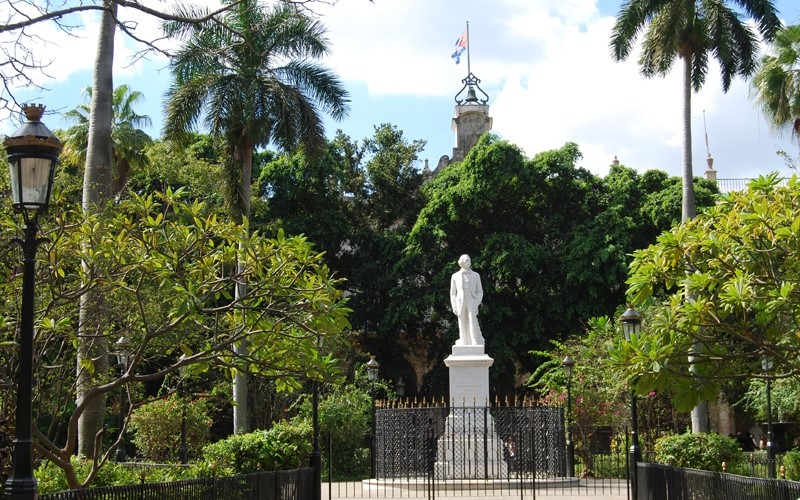 Few steps
away from the village´s foundation site, it was built between the
Parochial Church and the Real Fuerza Castle, spot that grouped the
political, military, religious and civilian functions of an emerging
population. Used for military exercises in the 1700s, it is surrounded
by important public buildings of the time as the Royal Post Office
(1772-1790), subsequently the Lieutenant Governor’s Palace; the
Governor´s Palace, the City´s Museum since 1968; the Count of
Santovenia’s Palace, today Santa Isabel Hotel, and El Templete.
Few steps
away from the village´s foundation site, it was built between the
Parochial Church and the Real Fuerza Castle, spot that grouped the
political, military, religious and civilian functions of an emerging
population. Used for military exercises in the 1700s, it is surrounded
by important public buildings of the time as the Royal Post Office
(1772-1790), subsequently the Lieutenant Governor’s Palace; the
Governor´s Palace, the City´s Museum since 1968; the Count of
Santovenia’s Palace, today Santa Isabel Hotel, and El Templete. Fusterlandia is an ongoing project at Jaimanitas, West of Havana, where Cuban artist José Fuster has turned his home neighborhood into a masterpiece of outstanding tilework and bright colors. He has scattered his imagination from his own house to the rest of the community, decorating houses from roof to foundations with art, sculpture and mosaic tiles of every color and description. Deep influence of Gaudi modernism, Santería and Cuban culture runs through almost every snippet of this unique urban art.
Fusterlandia is an ongoing project at Jaimanitas, West of Havana, where Cuban artist José Fuster has turned his home neighborhood into a masterpiece of outstanding tilework and bright colors. He has scattered his imagination from his own house to the rest of the community, decorating houses from roof to foundations with art, sculpture and mosaic tiles of every color and description. Deep influence of Gaudi modernism, Santería and Cuban culture runs through almost every snippet of this unique urban art. 1
1 2
2 3
3 4
4 5
5 6
6 7
7 8
8 9
9 10
10 11
11 12
12 13
13 14
14 15
15 Construction
of this fortress was designed by Bautista Antonelli and built between
1589 and 1630. The original lighthouse was rebuilt many times, the one
that still stands today is from 1845 and has its original lamp. Havana
was a highly prized target for enemies and pirates for its extremely
favorable strategic position in the Caribbean and became the most
fortified city in any Spanish colony. It was declared a UNESCO site as
part of the city´s defense system along with other fortresses as
La Cabaña, La Real Fuerza, La Punta, etc.
Construction
of this fortress was designed by Bautista Antonelli and built between
1589 and 1630. The original lighthouse was rebuilt many times, the one
that still stands today is from 1845 and has its original lamp. Havana
was a highly prized target for enemies and pirates for its extremely
favorable strategic position in the Caribbean and became the most
fortified city in any Spanish colony. It was declared a UNESCO site as
part of the city´s defense system along with other fortresses as
La Cabaña, La Real Fuerza, La Punta, etc. The most famous nightclub in Cuba is located in the outskirts of Havana. Many legendary figures of the 20th century have performed here, including Josephine Baker and Nat King Cole. The Tropicana was originally a farm estate which was transformed in the 1930s into a vast nightspot with a restaurant and casino opening on December 31st, 1939. At the main entrance is the Fountain of the Muses (1952) and the statue of a ballet dancer, by Rita Longa (1959) is now the symbol of the club.
The most famous nightclub in Cuba is located in the outskirts of Havana. Many legendary figures of the 20th century have performed here, including Josephine Baker and Nat King Cole. The Tropicana was originally a farm estate which was transformed in the 1930s into a vast nightspot with a restaurant and casino opening on December 31st, 1939. At the main entrance is the Fountain of the Muses (1952) and the statue of a ballet dancer, by Rita Longa (1959) is now the symbol of the club. 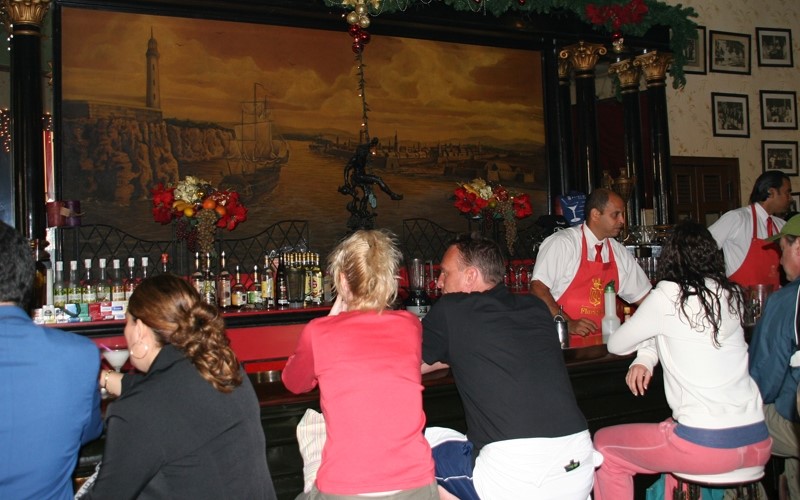 Ernest Hemingway’s favorite place to enjoy his daiquiri. In 1953 it was
considered one of the seven most famous bars in the world, and in 1992,
the American Academy of Gastronomical Science presented the Floridita
with the Best of the Best Five Star Diamond Award. Kwon as the “cradle
of the Daiquiri”, it still keeps its original Regency décor from 1950s.
Ernest Hemingway’s favorite place to enjoy his daiquiri. In 1953 it was
considered one of the seven most famous bars in the world, and in 1992,
the American Academy of Gastronomical Science presented the Floridita
with the Best of the Best Five Star Diamond Award. Kwon as the “cradle
of the Daiquiri”, it still keeps its original Regency décor from 1950s. A very well-known bar where Hemingway loved to drink mojitos and a one of the city’s great tourist attractions, where countless visitors have left their imprint in a souvenir, a photo or on its graffiti covered walls. Here you will find signatures by Errol Flynn, Nat King Cole, Ernest Hemingway, Pablo Neruda, Gabriel García Márquez, Alejo Carpentier and Nicolás Guillen, among many others.
A very well-known bar where Hemingway loved to drink mojitos and a one of the city’s great tourist attractions, where countless visitors have left their imprint in a souvenir, a photo or on its graffiti covered walls. Here you will find signatures by Errol Flynn, Nat King Cole, Ernest Hemingway, Pablo Neruda, Gabriel García Márquez, Alejo Carpentier and Nicolás Guillen, among many others. This
charming hotel from 1923, eclectically decorated, is rich in literary
memories. The American writer Ernest Hemingway stayed here for long
periods during the 1930´s writing fishing chronicles and began to write
his novel For Whom the Bell Tolls. Room 511, where he mostly stayed is
now a museum that features personal belongings and pictures of the
author.
This
charming hotel from 1923, eclectically decorated, is rich in literary
memories. The American writer Ernest Hemingway stayed here for long
periods during the 1930´s writing fishing chronicles and began to write
his novel For Whom the Bell Tolls. Room 511, where he mostly stayed is
now a museum that features personal belongings and pictures of the
author. Sloppy Joe's was a spectacular Havana bar in the 30's. Ernest Hemingway was a regular with his pal, Joe Russell who was the owner of another Sloppy Joe's Bar in Cayo Hueso, a name Hemingway had suggested in honor to Mr. Garcia, the owner, who ran his business very messy and careless at first, hence the name of Sloppy Joe. A sandwich served here, made of shredded beef "ropa vieja”, was worldwide known as Sloppy Joe´s. It was also a very popular place for having the longest mahogany drinks cabinet of Cuba.
Sloppy Joe's was a spectacular Havana bar in the 30's. Ernest Hemingway was a regular with his pal, Joe Russell who was the owner of another Sloppy Joe's Bar in Cayo Hueso, a name Hemingway had suggested in honor to Mr. Garcia, the owner, who ran his business very messy and careless at first, hence the name of Sloppy Joe. A sandwich served here, made of shredded beef "ropa vieja”, was worldwide known as Sloppy Joe´s. It was also a very popular place for having the longest mahogany drinks cabinet of Cuba. Fábrica de Arte Cubano is one of Havana’s finest new art projects, an interactive place for live music, art expos, fashion shows. This converted cooking-oil factory in Vedado founded by Cuban fusion musician X-Alfonso in 2014 is a cultural-social project which aims at supporting and promoting young artists work from all art expressions such as cinema, music, dance, theatre, plastic arts, literature, photography, fashion and graphic design.
Fábrica de Arte Cubano is one of Havana’s finest new art projects, an interactive place for live music, art expos, fashion shows. This converted cooking-oil factory in Vedado founded by Cuban fusion musician X-Alfonso in 2014 is a cultural-social project which aims at supporting and promoting young artists work from all art expressions such as cinema, music, dance, theatre, plastic arts, literature, photography, fashion and graphic design. 2
2 5
5 7
7 14
14 15
15 16
16 At San
Francisco de Paula on the outskirts of Havana, this villa was built in
1887 and bought by Hemingway in 1940 where he lived for 20 years and
wrote some his novels. It was turned into a museum in 1962 after his
death and displays over 1000 books library, hunting trophies, the author
personal belongings, etc. Two curios features in the garden are the cat
cemetery and the author´s fishing boat El Pilar which he also used to
patrol the sea north of Cuba, on the outlook of Nazi submarines that
were in the area to sink ships laden with sugar intended for the allied
troops.
At San
Francisco de Paula on the outskirts of Havana, this villa was built in
1887 and bought by Hemingway in 1940 where he lived for 20 years and
wrote some his novels. It was turned into a museum in 1962 after his
death and displays over 1000 books library, hunting trophies, the author
personal belongings, etc. Two curios features in the garden are the cat
cemetery and the author´s fishing boat El Pilar which he also used to
patrol the sea north of Cuba, on the outlook of Nazi submarines that
were in the area to sink ships laden with sugar intended for the allied
troops. This small
fishermen town, east of Havana, was the place that harbored Hemingway´s
boat “El Pilar” and became the setting for his book “The Old Man and the
Sea”. There is a monument featuring a bust of the writer and nearby on
the seafront, a small fort (1649) stands as the eastern most defense
point of the city where this community emerged.
This small
fishermen town, east of Havana, was the place that harbored Hemingway´s
boat “El Pilar” and became the setting for his book “The Old Man and the
Sea”. There is a monument featuring a bust of the writer and nearby on
the seafront, a small fort (1649) stands as the eastern most defense
point of the city where this community emerged. 12
12 13
13 Viñales valley and a section of this Mountain Range where it is located became in 1999 a National Park and was declared by UNESCO a World Heritage Site in the category of Cultural landscape. This overwhelming landscape houses 17 botanical species and 47 archeological sites, most of them related to aboriginal communities and runaway African slaves. It features unique gigantic limestone hillocks, mogotes, honeycombed with cavities which resemble a huge church organ, therefore the name Sierra de los Organos, Organs Mountain Range.
Viñales valley and a section of this Mountain Range where it is located became in 1999 a National Park and was declared by UNESCO a World Heritage Site in the category of Cultural landscape. This overwhelming landscape houses 17 botanical species and 47 archeological sites, most of them related to aboriginal communities and runaway African slaves. It features unique gigantic limestone hillocks, mogotes, honeycombed with cavities which resemble a huge church organ, therefore the name Sierra de los Organos, Organs Mountain Range.
 This cave
discovered in 1920, lies in the San Vicente Valley. The first part of the tour here is on foot and then a motorboat takes visitors through a river which runs inside the cave. It´s plenty of gorgeous stalactites and stalagmites, some of which resemble animals, ships, skull, etc.
This cave
discovered in 1920, lies in the San Vicente Valley. The first part of the tour here is on foot and then a motorboat takes visitors through a river which runs inside the cave. It´s plenty of gorgeous stalactites and stalagmites, some of which resemble animals, ships, skull, etc. Located at Dos Hermanas Valley, this spectacular Mural (120 meters high and 160 meters long) was painted by Leovigildo Gonzáles Morillo who was Chief Cartographer of the Cuban Academy of Science. The face of a limestone hillock features the history of local evolution from ammonites to Hommo Sapiens.
Located at Dos Hermanas Valley, this spectacular Mural (120 meters high and 160 meters long) was painted by Leovigildo Gonzáles Morillo who was Chief Cartographer of the Cuban Academy of Science. The face of a limestone hillock features the history of local evolution from ammonites to Hommo Sapiens. In the depths of San Miguel´s cave, there is a Palenque, run away refuge, which houses a museum now. Cimarrones were runaway slaves who hid in the mountains or forests to avoid those whose job it was to capture them alive or dead. These fugitives organized frequent revolts which were almost inevitably suppressed with bloodshed.
In the depths of San Miguel´s cave, there is a Palenque, run away refuge, which houses a museum now. Cimarrones were runaway slaves who hid in the mountains or forests to avoid those whose job it was to capture them alive or dead. These fugitives organized frequent revolts which were almost inevitably suppressed with bloodshed. They are among the most ancient rocks in Cuba and all what remains of a limestone plateau. Over a period lasting millions of years, underground aquifers eroded the softer limestone giving rise to large caverns whose ceiling later collapsed. Only the hard lime stone pillars, mogotes, were left standing. They are covered with thick vegetation where some endemic plant species have adapted to life on their craggy crevices.
They are among the most ancient rocks in Cuba and all what remains of a limestone plateau. Over a period lasting millions of years, underground aquifers eroded the softer limestone giving rise to large caverns whose ceiling later collapsed. Only the hard lime stone pillars, mogotes, were left standing. They are covered with thick vegetation where some endemic plant species have adapted to life on their craggy crevices. In Cuba, the
process of tobacco growing is the result of age old expertise handed
down to generations. Tobacco plants are very delicate and need skilful handling. There two types: Corojo, grown in green houses, which has the finest leaves, selected as the cigar´s wrapper, and Criollo, which grows outdoors and provides the cigar´s filler and its binder. Harvesting tobacco is a laborious operation. The leaves are tied in bunches and put to dry in sheds hanging on horizontal poles. Humidification is a hydrating process carried out after the drying so that the leaves do not dry out.
In Cuba, the
process of tobacco growing is the result of age old expertise handed
down to generations. Tobacco plants are very delicate and need skilful handling. There two types: Corojo, grown in green houses, which has the finest leaves, selected as the cigar´s wrapper, and Criollo, which grows outdoors and provides the cigar´s filler and its binder. Harvesting tobacco is a laborious operation. The leaves are tied in bunches and put to dry in sheds hanging on horizontal poles. Humidification is a hydrating process carried out after the drying so that the leaves do not dry out. 1
1 2
2 3
3 4
4 5
5 6
6